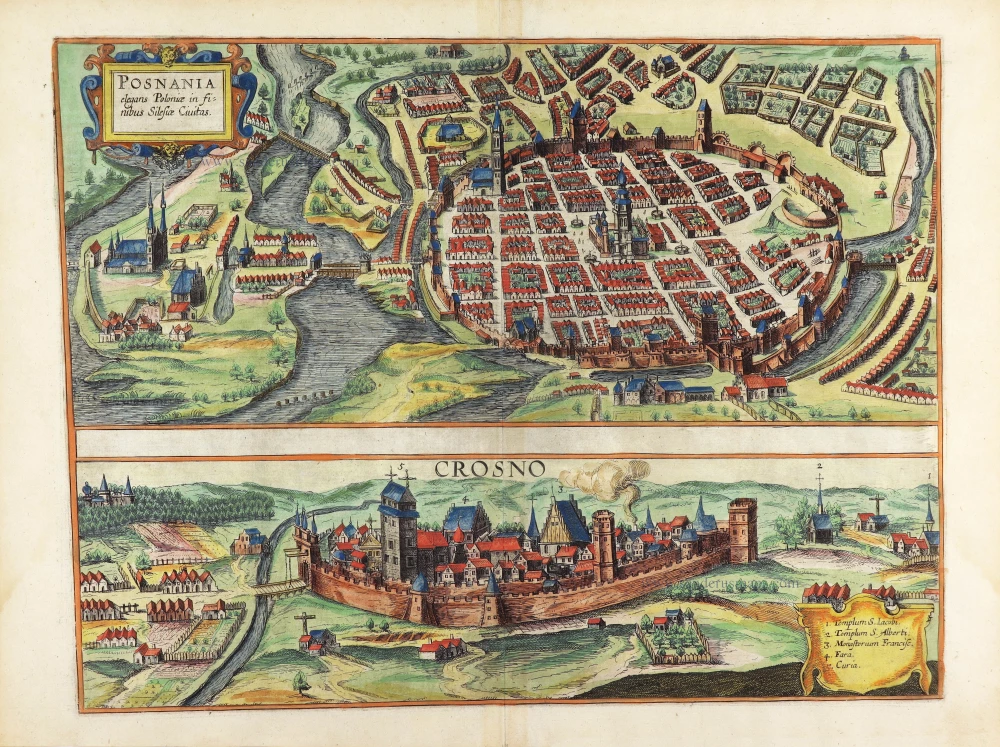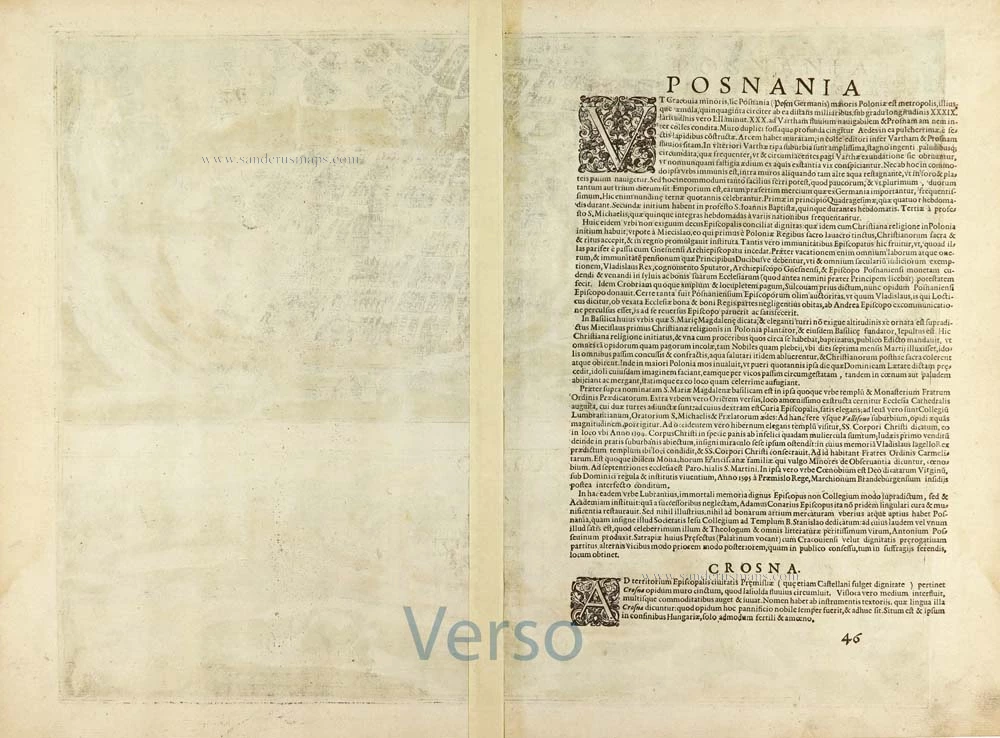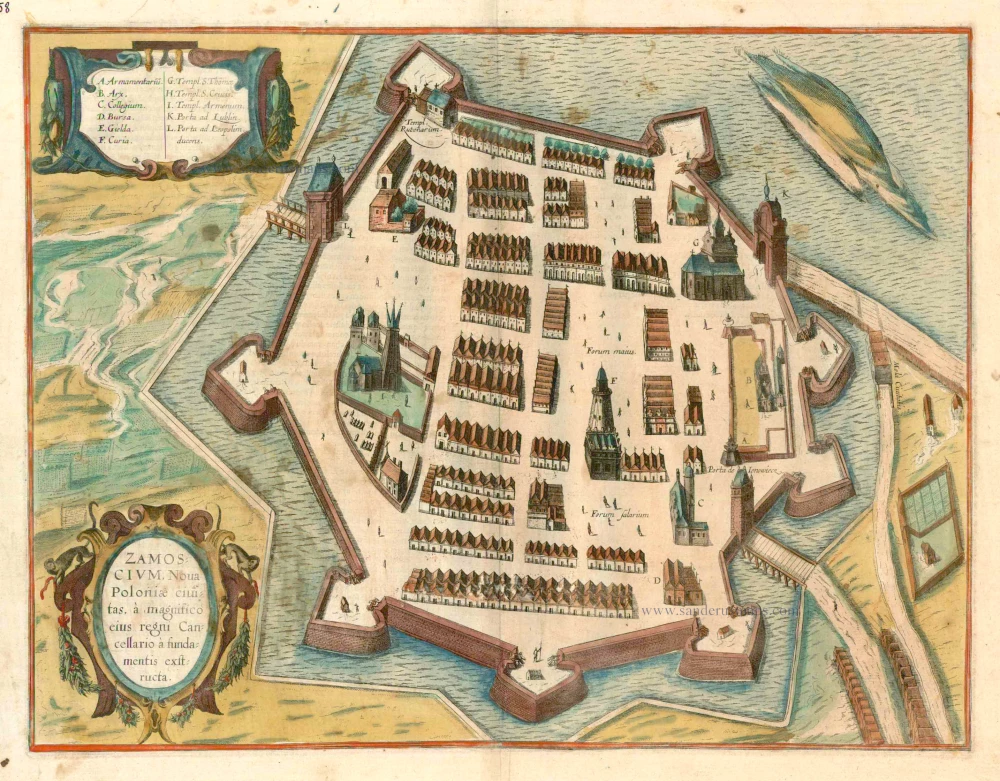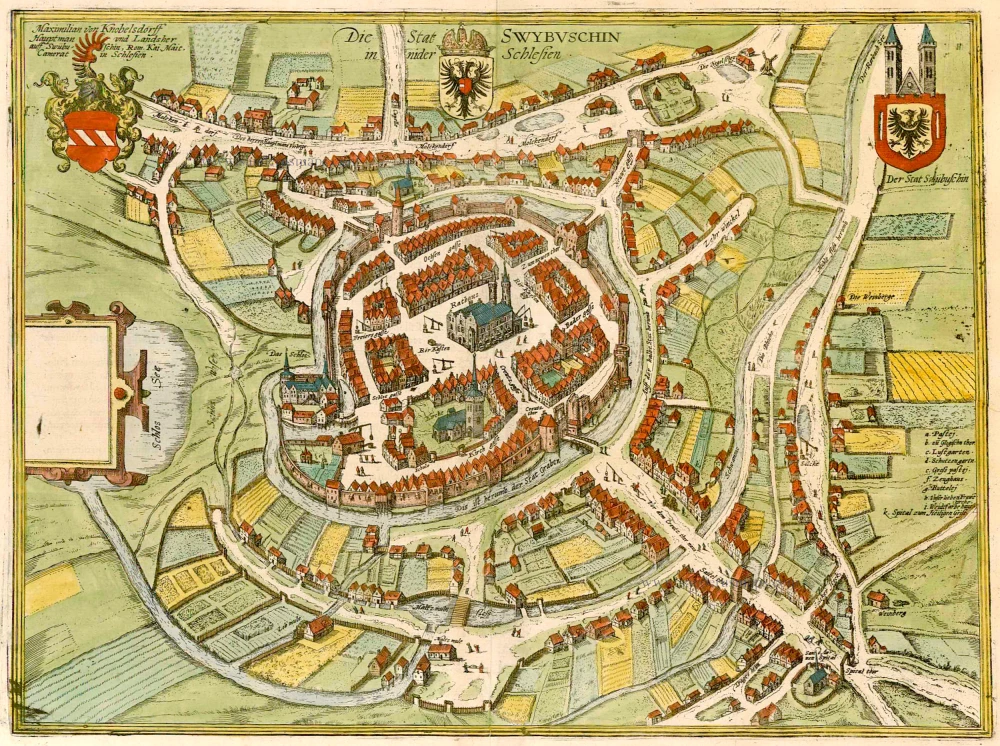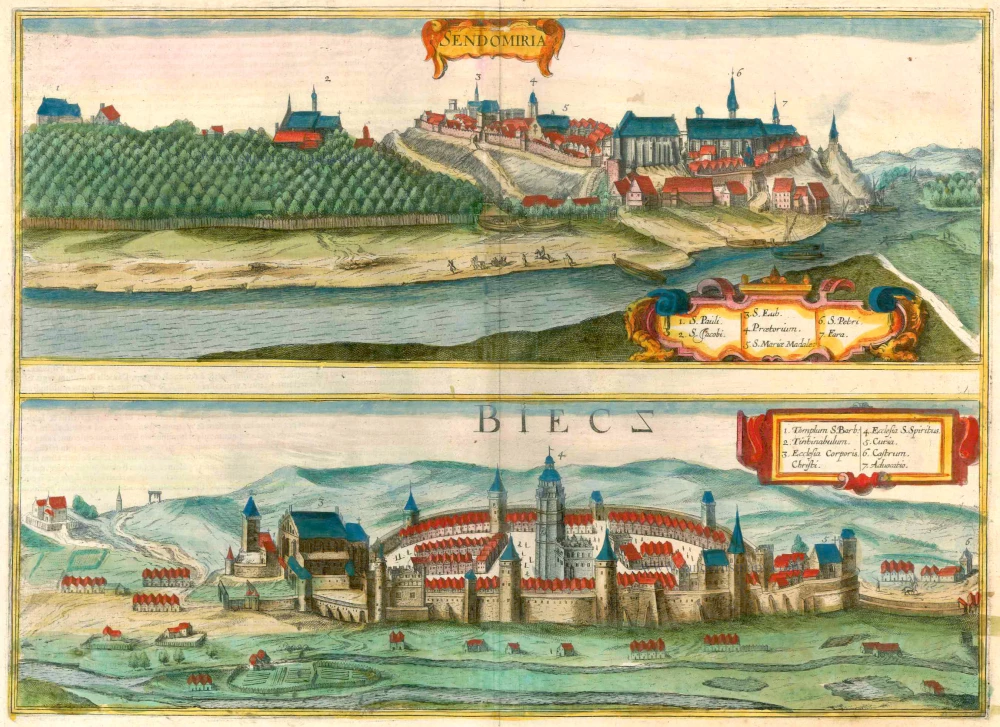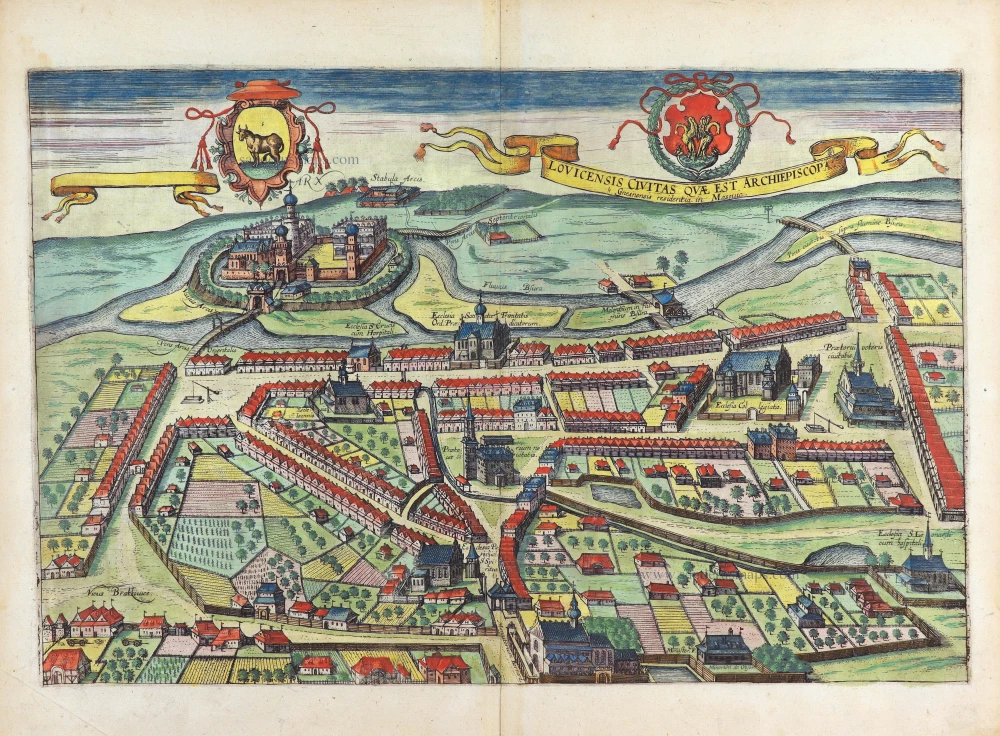Poznan and Krosno, by Georg Braun and Frans Hogenberg. 1617-18
POZNAN
CARTOUCHE: Poznan is an elegant Polish city in the Silesia region.
COMMENTARY BY BRAUN (on verso): "The kingdom of Poland and the other lands incorporated are divided into Lesser Poland and Greater Poland. Just as Cracow is the capital of Lesser Poland, Poznan is the capital of Greater Poland, Yet the former has the advantage of being the royal residence. [...] The city's most elegant embellishment is the cathedral, built by Mieszko right at the beginning when he accepted the Christian religion and introduced it into Poland."
In this bird's-eye view from the north, the magnificent 14th-century town hall rises imposingly in the centre of the walled city. On the left is the cathedral Island in the river Warta, with the cathedral of SS Peter and Paul. Mieszko I erected a castle on this island, where he founded the first Polish diocese in 968, the Piast state's first residence. The city was laid out in a grid pattern in the 13th century and developed into a flourishing European trade centre. Today, it has a population of 565,000 and is an essential academic and cultural centre in Poland.
KROSNO
This city, shown from a south-westerly direction and not described in the city atlas, is constructed like a fortress with a double wall and mighty towers. A drawbridge over the Wislok is the only direct means of access to the city. The town hall (4), the parish church of St Mary (5) and the Franciscan monastery with its high-pitched roof (3) dominates the silhouette of the city. Mentioned for the first time in 1282, the town passed to Poland under Casimir I and was granted a municipal charter around 1340. The town was a substantial linen, cloth and Hungarian wine trade centre. Like almost all Polish cities, Krosno prospered in the 16th century. (Taschen)
Braun G. & Hogenberg F. and the Civitates Orbis Terrarum.
The Civitates Orbis Terrarum, also known as the 'Braun & Hogenberg', is a six-volume town atlas and the most excellent book of town views and plans ever published: 363 engravings, sometimes beautifully coloured. It was one of the best-selling works in the last quarter of the 16th century. Georg Braun, a skilled writer, wrote the text accompanying the plans and views on the verso. Many plates were engraved after the original drawings of a professional artist, Joris Hoefnagel (1542-1600). The first volume was published in Latin in 1572 and the sixth in 1617. Frans Hogenberg, a talented engraver, created the tables for volumes I through IV, and Simon van den Neuwel made those for volumes V and VI. Other contributors were cartographers Daniel Freese and Heinrich Rantzau, who provided valuable geographical information. Works by Jacob van Deventer, Sebastian Münster, and Johannes Stumpf were also used as references. Translations appeared in German and French, making the atlas accessible to a wider audience.
Since its original publication of volume 1 in 1572, the Civitates Orbis Terrarum has left an indelible mark on the history of cartography. The first volume was followed by seven more editions in 1575, 1577, 1582, 1588, 1593, 1599, and 1612. Vol.2, initially released in 1575, saw subsequent editions in 1597 and 1612. The subsequent volumes, each a treasure trove of historical insights, graced the world in 1581, 1588, 1593, 1599, and 1606. The German translation of the first volume, a testament to its widespread appeal, debuted in 1574, followed by the French edition in 1575.
Several printers were involved: Theodor Graminaeus, Heinrich von Aich, Gottfried von Kempen, Johannis Sinniger, Bertram Buchholtz, and Peter von Brachel, all of whom worked in Cologne.
Georg Braun (1541-1622)
Georg Braun, the author of the text accompanying the plans and views in the Civitates Orbis Terrarum, was born in Cologne in 1541. After his studies in Cologne, he entered the Jesuit Order as a novice, indicating his commitment to learning and intellectual pursuits. In 1561, he obtained his bachelor's degree; in 1562, he received his Magister Artium, further demonstrating his academic achievements. Although he left the Jesuit Order, he continued his studies in theology, gaining a licentiate in theology. His theological background likely influenced the content and tone of the text in the Civitates Orbis Terrarum, adding a unique perspective to the work.
Frans Hogenberg (1535-1590)
Frans Hogenberg was a Flemish and German painter, engraver, and mapmaker. He was born in Mechelen as the son of Nicolaas Hogenberg.
By the end of the 1560s, Frans Hogenberg was employed upon Abraham Ortelius's Theatrum Orbis Terrarum, published in 1570; he is named an engraver of numerous maps. In 1568, he was banned from Antwerp by the Duke of Alva and travelled to London, where he stayed a few years before emigrating to Cologne. He immediately embarked on his two most important works, the Civitates, published in 1572 and the Geschichtsblätter, which appeared in several series from 1569 until about 1587.
Thanks to large-scale projects like the Geschichtsblätter and the Civitates, Hogenberg's social circumstances improved with each passing year. He died as a wealthy man in Cologne in 1590.
Posnania elegans Poloniae in finibus Silesiae Civitatis. [on sheet with] Crosno.
Item Number: 29283 Authenticity Guarantee
Category: Antique maps > Europe > Eastern Europe
Old, antique bird’s-eye view plan of Poznan and Krosno, by Georg Braun and Frans Hogenberg.
Title: Posnania elegans Poloniae in finibus Silesiae Civitatis. [on sheet with] Crosno.
Date of the first edition: 1617.
Date of this map: 1617-18.
Copper engraving, printed on paper.
Map size: 350 x 460mm (13.78 x 18.11 inches).
Sheet size: 395 x 530mm (15.55 x 20.87 inches).
Verso: Latin text.
Condition: Original coloured, excellent.
Condition Rating: A+.
From: Civitates Orbis Terrarum. Theatri praecipuarum Totius Mundi Urbium Liber Sextus Anno MDCXVIII. Cologne, Anton Heirat, 1617-18. (Van der Krogt 4, 41:1.6)
POZNAN
CARTOUCHE: Poznan is an elegant Polish city in the Silesia region.
COMMENTARY BY BRAUN (on verso): "The kingdom of Poland and the other lands incorporated are divided into Lesser Poland and Greater Poland. Just as Cracow is the capital of Lesser Poland, Poznan is the capital of Greater Poland, Yet the former has the advantage of being the royal residence. [...] The city's most elegant embellishment is the cathedral, built by Mieszko right at the beginning when he accepted the Christian religion and introduced it into Poland."
In this bird's-eye view from the north, the magnificent 14th-century town hall rises imposingly in the centre of the walled city. On the left is the cathedral Island in the river Warta, with the cathedral of SS Peter and Paul. Mieszko I erected a castle on this island, where he founded the first Polish diocese in 968, the Piast state's first residence. The city was laid out in a grid pattern in the 13th century and developed into a flourishing European trade centre. Today, it has a population of 565,000 and is an essential academic and cultural centre in Poland.
KROSNO
This city, shown from a south-westerly direction and not described in the city atlas, is constructed like a fortress with a double wall and mighty towers. A drawbridge over the Wislok is the only direct means of access to the city. The town hall (4), the parish church of St Mary (5) and the Franciscan monastery with its high-pitched roof (3) dominates the silhouette of the city. Mentioned for the first time in 1282, the town passed to Poland under Casimir I and was granted a municipal charter around 1340. The town was a substantial linen, cloth and Hungarian wine trade centre. Like almost all Polish cities, Krosno prospered in the 16th century. (Taschen)
Braun G. & Hogenberg F. and the Civitates Orbis Terrarum.
The Civitates Orbis Terrarum, also known as the 'Braun & Hogenberg', is a six-volume town atlas and the most excellent book of town views and plans ever published: 363 engravings, sometimes beautifully coloured. It was one of the best-selling works in the last quarter of the 16th century. Georg Braun, a skilled writer, wrote the text accompanying the plans and views on the verso. Many plates were engraved after the original drawings of a professional artist, Joris Hoefnagel (1542-1600). The first volume was published in Latin in 1572 and the sixth in 1617. Frans Hogenberg, a talented engraver, created the tables for volumes I through IV, and Simon van den Neuwel made those for volumes V and VI. Other contributors were cartographers Daniel Freese and Heinrich Rantzau, who provided valuable geographical information. Works by Jacob van Deventer, Sebastian Münster, and Johannes Stumpf were also used as references. Translations appeared in German and French, making the atlas accessible to a wider audience.
Since its original publication of volume 1 in 1572, the Civitates Orbis Terrarum has left an indelible mark on the history of cartography. The first volume was followed by seven more editions in 1575, 1577, 1582, 1588, 1593, 1599, and 1612. Vol.2, initially released in 1575, saw subsequent editions in 1597 and 1612. The subsequent volumes, each a treasure trove of historical insights, graced the world in 1581, 1588, 1593, 1599, and 1606. The German translation of the first volume, a testament to its widespread appeal, debuted in 1574, followed by the French edition in 1575.
Several printers were involved: Theodor Graminaeus, Heinrich von Aich, Gottfried von Kempen, Johannis Sinniger, Bertram Buchholtz, and Peter von Brachel, all of whom worked in Cologne.
Georg Braun (1541-1622)
Georg Braun, the author of the text accompanying the plans and views in the Civitates Orbis Terrarum, was born in Cologne in 1541. After his studies in Cologne, he entered the Jesuit Order as a novice, indicating his commitment to learning and intellectual pursuits. In 1561, he obtained his bachelor's degree; in 1562, he received his Magister Artium, further demonstrating his academic achievements. Although he left the Jesuit Order, he continued his studies in theology, gaining a licentiate in theology. His theological background likely influenced the content and tone of the text in the Civitates Orbis Terrarum, adding a unique perspective to the work.
Frans Hogenberg (1535-1590)
Frans Hogenberg was a Flemish and German painter, engraver, and mapmaker. He was born in Mechelen as the son of Nicolaas Hogenberg.
By the end of the 1560s, Frans Hogenberg was employed upon Abraham Ortelius's Theatrum Orbis Terrarum, published in 1570; he is named an engraver of numerous maps. In 1568, he was banned from Antwerp by the Duke of Alva and travelled to London, where he stayed a few years before emigrating to Cologne. He immediately embarked on his two most important works, the Civitates, published in 1572 and the Geschichtsblätter, which appeared in several series from 1569 until about 1587.
Thanks to large-scale projects like the Geschichtsblätter and the Civitates, Hogenberg's social circumstances improved with each passing year. He died as a wealthy man in Cologne in 1590.

